Skin Disorders in Older Adults: Eczematous and Xerotic Inflammatory Conditions, Part 1
Because epidermal integrity decreases with age, eczematous inflammatory dermatoses are more common among older adults than among younger persons.
ABSTRACT: Because epidermal integrity decreases with age, eczematous inflammatory dermatoses are more common among older adults than among younger persons. Initial therapy for seborrheic dermatitis consists of mild topical corticosteroids (class IV or weaker) and topical antifungal agents used once or twice a day, either alone or in combination. The goal of therapy for xerosis is to keep the skin moist. Topical corticosteroids are not needed; however, these agents are used to treat a related condition-asteatotic eczema. The cornerstones of treatment of nummular dermatitis are emollients and topical corticosteroids.
Key words: eczema, seborrheic dermatitis, xerosis, asteatotic eczema, nummular dermatitis
Inflammatory skin disorders are manifestations-for the most part-of the immune response, which wanes with age.1 Thus, it is not surprising that most of these dermatoses are less common in older adults. However, because epidermal integrity also decreases with age, the prevalence of eczematous inflammatory dermatoses is higher among persons older than 60 years.
In this article, I focus on seborrheic dermatitis, xerosis, asteatotic eczema, and nummular dermatitis; I describe and illustrate these conditions, and I discuss their treatment. In a coming issue, I will address stasis dermatitis, irritant contact dermatitis, and allergic contact dermatitis.
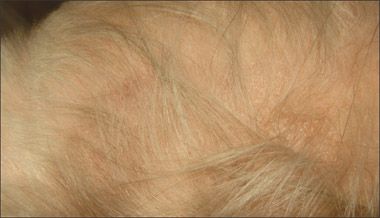
Figure 1 – Erythematous patches that are typical of seborrheic dermatitis can be seen on the scalp of this elderly man.
SEBORRHEIC DERMATITIS

Figure 2 – White scales on the face of this man represent seborrheic dermatitis.
Clinical features. Seborrheic dermatitis appears as erythematous plaques or patches topped by white or yellow scale. It most commonly affects the scalp (Figure 1) and the face (Figure 2), particularly the ears (Figure 3), eyebrows, and nasal alae; however, it can also manifest on the chest, anus, and groin, the so-called seborrheic areas. In persons of color, seborrheic dermatitis sometimes appears simply as white, minimally scaly patches on the face underlying the eyebrows. Rarely, seborrheic dermatitis can become secondarily infected with gram-positive organisms (Figure 4).
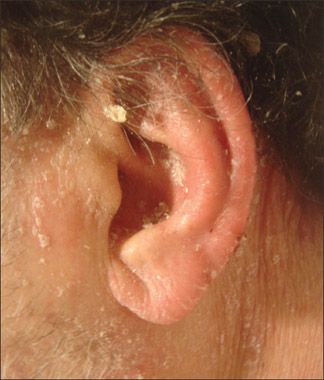
Figure 3 – Greasy yellowish white scales in and around the ear are characteristic of seborrheic dermatitis.
Prevalence, associated diseases, and causes. The prevalence of seborrheic dermatitis among the general population is estimated to be 1% to 5%; however, simple scaling of the scalp (dandruff) is more common. Seborrheic dermatitis tends to affect men more frequently than women.2 The prevalence also seems to be increased in patients with neurological diseases such as Parkinson disease (35% of patients) and post-stroke neuropathies.3 Other diseases associated with seborrheic dermatitis include epilepsy, congestive heart failure, obesity, and chronic alcoholism. Various factors contribute to seborrheic dermatitis, including the presence of sebaceous glands and sebum, overgrowth of Pityrosporum ovale (Malassezia furfur), stress, low humidity and temperature, and activation of the alternative complement pathway.
Treatment. Initial treatment of seborrheic dermatitis consists of mild topical corticosteroids (class IV or weaker) and topical antifungal agents used once or twice a day, either alone or in combination. Fluocinolone acetonide 0.01% scalp oil (Derma-Smoothe/FS) is especially helpful in patients who have thick scalp plaques. Corticosteroids in foam preparations have high acceptance among patients with seborrheic dermatitis of the scalp.

Figure 4 – Secondary infection of seborrheic dermatitis, shown here in an elderly woman, is uncommon.
Shampoos with antifungal agents, salicylic acid, tar, selenium sulfide, corticosteroids, and zinc pyrithione all are helpful in treating seborrheic dermatitis of the scalp. To increase the effectiveness of these shampoos, tell patients to alternate them (eg, antifungal on Monday, zinc on Tuesday, selenium on Wednesday, tar on Thursday, etc).
Topical calcineurin inhibitors (eg, tacrolimus, pimecrolimus) can be useful, particularly when rosacea and seborrheic dermatitis overlap. I treat severe seborrheic dermatitis with oral antifungal agents.
XEROSIS
Clinical features. Xerosis is common in elderly persons; it is characterized by pruritic, dry, cracked, and fissured skin (Figure 5). Visible xerosis occurs most frequently on the legs. Sometimes the condition is so severe as to overlap with ichthyosis, which manifests with thick, fish scale–like xerotic plaques (Figure 6). It can also occur in association with tinea pedis (Figure 7).

Figure 5 – Xerosis and lichen simplex chronicus are evident on this patient's arm.
Xerotic skin has the appearance of cracked porcelain; the cracks arise from loss of water from the epidermis. Xerosis disrupts the desquamation process; powdery flakes develop and become visible on the surface of the skin. In the winter, when humidity is lower, xerosis tends to be more severe.
Causes. Although xerosis can be considered an inflammatory dermatosis because it is often accompanied by erythema and some inflammation, the condition results in large part from physical changes in the skin that occur with normal aging. The decreased activity of sebaceous and sweat glands in elderly persons is one of the main contributing factors. Decreased skin thickness (ie, thin skin caused by inappropriate or pathological desquamation) and decreased hydration also play key roles in the development of xerosis.
Treatment. The treatment of xerosis involves keeping the skin moist. A home humidifier is helpful, particularly when it is kept in the bedroom. Mild soaps and bath oils can be used when bathing to preserve the natural oils of the skin. Natural emollients of the skin must be replaced after showering. Moisturizers, particularly those with dimethicone 1% (silicone), can be applied to damp skin to seal in the moisture that the skin takes up when exposed to water. Ammonium lactate 12% lotion is also very effective in rehydrating xerotic skin.
In addition, patients should avoid washcloths, rough clothing, and abrasives that can abrade the skin. Topical corticosteroids are not needed to treat xerosis; however, they are used to treat a form of eczema related to it-asteatotic eczema.
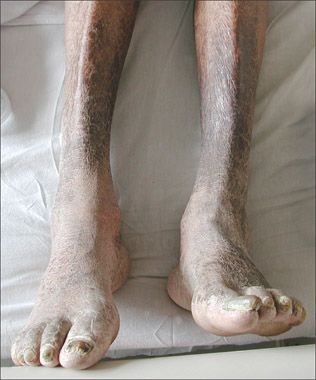
Figure 6 – Thick, fish scale–like xerotic plaques on this man's legs and feet represent ichthyosis.
ASTEATOTIC ECZEMA
Clinical features. Asteatotic eczema, also known as eczema craquel, is an inflammatory dermatosis that arises on xerotic skin. Other terms for it include xerotic eczema and "winter itch." It occurs primarily in the winter and is seen most frequently in elderly patients with xerosis. Diuretics can also promote the development of asteatotic eczema.4
This dermatosis usually occurs on the anterolateral aspect of the lower legs. Initially, the skin becomes dry and scaly, then red plaques develop from scratching (Figure 8). The erythematous skin can resemble cracked porcelain or "crazy paving."
Treatment. The treatment of asteatotic eczema is similar to that of xerosis; however, I also prescribe a class V or VI topical corticosteroid that can be added to lactic acid 12% cream or lotion.
NUMMULAR DERMATITIS
Clinical features. Nummular ("coin-shaped") or discoid dermatitis or eczema is most common in men aged 50 to 70 years. The next highest incidence is in girls and women aged 10 to 30, in whom it is frequently associated with atopic dermatitis. The condition often flares in the fall and winter as the ambient temperature and humidity level drop.5
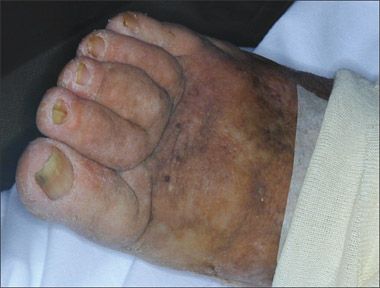
Figure 7 – Xerosis, tinea pedis, and stasis dermatitis overlap in this patient.
Nummular dermatitis typically occurs on the lower leg, but it can affect any part of the body. One, several, or numerous patches appear and may persist for weeks or months. The skin between the patches is often xerotic and marked by fine scale.

Figure 8 – This red plaque developed after the patient had habitually scratched the xerotic skin on her legs.
Most patches or plaques are round or oval (Figure 9) and range from a few millimeters to several centimeters in diameter. They are typically pink, red, or brown and well defined. In persons of color, nummular dermatitis commonly appears purple. The surface of the lesions may be dry and cracked or eroded, blistered, and crusted. Initially, vesicles containing serous exudate occur on the surface of the patches, which can be highly pruritic.
Nummular dermatitis often resolves without a trace. However, in patients who have darker skin, postinflammatory hyperpigmentation or hypopigmentation may persist for months.
Diagnosis. Nummular dermatitis can usually be diagnosed clinically; however, the lesions may be mistaken for tinea corporis, psoriasis, contact dermatitis, and even cancer. It can resemble pityriasis rosea, although pityriasis rosea usually occurs on the torso, not on the legs as nummular dermatitis does. Distinguishing asteatotic eczema and atopic dermatitis from nummular dermatitis can be challenging; they all have a similar histological appearance. The distinction is not clinically relevant, however, because the treatment of all these types of eczema is the same.
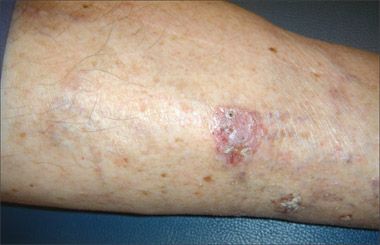
Figure 9 – This discoid erythematous plaque on a man's leg is characteristic of nummular dermatitis.
Other conditions that can resemble and occur with nummular dermatitis include:
Hair follicles and pores should be visible in patches of nummular dermatitis; the absence of these appendiceal structures raises suspicion of skin cancer.
CLINICAL HIGHLIGHTS
If there is any confusion about the diagnosis, bacterial cultures to detect Staphylococcus aureus colonization or other infections can be done. Potassium hydroxide testing of skin scrapings is commonly performed to rule out tinea corporis, which resembles nummular dermatitis. Sometimes patch testing is done to determine whether a contact allergy is responsible for the dermatitis. In most cases, no specific allergy can be found.1
Treatment. The cornerstones of treatment of nummular dermatitis are emollients and topical corticosteroids. Emollients include bath oils, soap substitutes, and moisturizing creams. They can be applied to the affected area as frequently as needed to relieve itching, scaling, and dryness. Emollients should also be used on unaffected skin to reduce dryness. Products that contain lactic acid are very helpful for diffuse xerosis. If the dermatitis is not weeping, sealants such as petrolatum or hydrophilic ointment (wool grease) can be beneficial.
Topical corticosteroids help relieve the inflammation caused by nummular dermatitis. Products with higher potency are applied to the patches once or twice daily for about 15 days. The regimen can be repeated from time to time. Milder corticosteroids, such as hydrocortisone 2.5% cream or ointment or desonide 0.05% lotion, are safe for daily use if needed. Reserve oral corticosteroids and UV light phototherapy for severe cases.
If plaques of nummular dermatitis appear infected, I prescribe mupirocin ointment, applied 3 times a day to the affected area. If the infection is more severe, oral antibiotics such as dicloxacillin, cephalexin, or azithromycin can be used.
References:
REFERENCES:1. Nedorost ST, Stevens SR. Diagnosis and treatment of allergic skin disorders in the elderly. Drugs Aging. 2001;18:827-835.
2. Schwartz RA, Janusz CA, Janniger CK. Seborrheic dermatitis: an overview. Am Fam Physician. 2006;74: 125-130.
3. Piérard GE. Seborrheic dermatitis today, gone tomorrow? The link between the biocene and treatment. Dermatology. 2003;206:187-188.
4. Norman RA. Xerosis and pruritus in the elderly-recognition and management. In: Norman RA, ed. Diagnosis of Aging Skin Diseases. London: Springer London; 2008:chap 12.
5. Soter NA. Nummular eczematous dermatitis. In: Freedberg IM, Eisen AZ, Wolff K, et al, eds. Fitzpatrick's Dermatology in Internal Medicine. 6th ed. New York: McGraw-Hill; 2003:chap 123.